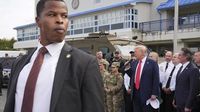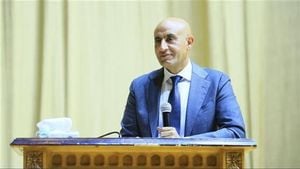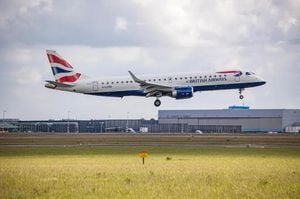On August 21, 2025, President Trump made a highly publicized visit to a U.S. Park Police facility in Southeast Washington, D.C., as part of his administration’s sweeping anti-crime initiative that has brought an unprecedented federal law enforcement and military presence to the nation’s capital. Arriving with hamburgers prepared at the White House and pizza from a local restaurant, Trump thanked federal agents and National Guard members for what he described as their vital role in restoring safety and order to the city.
“You’re incredible people. You make the country run, frankly,” Trump told the assembled officers, according to CBS News. The president, flanked by Attorney General Pam Bondi and Interior Secretary Doug Burgum, went on to promise that the capital would be “maxxed out in terms of beauty” within the next six to twelve months. He detailed plans to clean graffiti, repair park grass, and fix road medians, painting a picture of a city on the verge of transformation.
The visit was part of a broader campaign that has seen roughly 2,000 National Guard personnel—drawn from D.C. and several Republican-led states—deployed across the city, alongside a surge of officers from agencies including the FBI and Drug Enforcement Administration. The White House has described the effort as a necessary response to what the president has repeatedly characterized as rampant crime and homelessness in Washington. “I feel very safe now, and I’m hearing people are very safe, but I know within two weeks... it’s going to be at a level that’s even far superior,” Trump said during his visit, as reported by NPR.
Trump had earlier suggested he would personally join police and military patrols that evening, joking to radio host Todd Starnes, “I’m going to be going out tonight, I think, with the police, and with the military, of course. So we’re going to do a job. The National Guard is great. They’ve done a fantastic job.” However, his actual appearance was limited to the operations center for the U.S. Park Police on the Anacostia River, where he delivered his thanks and food.
Since the initiative began, the administration claims more than 630 arrests have been made and 86 illegal guns seized, according to Attorney General Bondi. The White House has also pointed to dozens of homeless encampments cleared and a bolstered sense of security among residents. “People that haven’t gone out to dinner in Washington, D.C., in two years are going out to dinner,” Trump asserted earlier in the week, a claim meant to underscore the perceived turnaround in public safety.
Yet, the crackdown has not been without controversy. The president’s move to assert federal control over the D.C. Metropolitan Police Department has drawn sharp criticism from local politicians, who view it as an affront to the city’s autonomy. The Justice Department recently blocked an attempt to install an emergency local police chief after a lawsuit from D.C. officials, reflecting ongoing tensions between federal authorities and the city government.
Local officials, including D.C.’s mayor, have argued that the initiative is both unnecessary and excessive. They point to police data showing that violent crime in Washington has been on a steady decline for the past year and a half, following a spike in 2023. As of August 11, 2025, robberies were down 28% and overall violent crime had dropped 26% compared to the previous year. In fact, according to the Justice Department, last year marked the lowest level of violent crime in the capital in more than three decades. Despite these statistics, Trump has dismissed the numbers as “phony” and vowed to “look into that,” suggesting a disconnect between the administration’s rhetoric and the city’s reported reality.
The federal show of force has been especially conspicuous. As The New York Times reported, the initial deployment included more than 800 D.C. National Guard troops, with another 1,000 arriving from other states. While the Guard’s primary role has been supportive—patrolling tourist-heavy areas like the National Mall and transit hubs—they have not, for the most part, directly enforced the law. Some National Guard lawyers have been transferred to the U.S. attorney’s office in Washington, acting as low-level civilian prosecutors, a move that blurs the traditional lines between military and civilian law enforcement.
More actively, a force of roughly 500 federal law enforcement agents has been assisting local police with arrests, conducting vehicle checkpoints, and carrying out targeted operations to seize illegal guns, recover stolen vehicles, and disrupt drug activity. The agents have also set up improvised security checkpoints, sometimes stopping vehicles for minor infractions, such as mismatched license plates or broken taillights, and conducting searches that have led to further scrutiny or arrests. In one instance, Park Police pulled over a FedEx employee because his plates did not match his vehicle registration, ultimately issuing only a warning after a sobriety test.
Immigration enforcement has also featured prominently in the crackdown. Of the 630 arrests reported by the White House, 251 involved suspected undocumented immigrants. While the city government maintains policies limiting collaboration with federal immigration authorities, Attorney General Bondi is seeking to end those restrictions. For now, a federal judge has allowed the administration to require city assistance on immigration enforcement, a decision that remains hotly contested in court.
Despite the administration’s focus on crime, federal agents have not concentrated their efforts on the city’s highest-crime neighborhoods. Instead, much of the activity has taken place in tourist areas, nightlife corridors, and locations like the 14th Street Corridor and Navy Yard. The White House has been tight-lipped about the cost of the operation, but estimates from similar deployments elsewhere suggest the price tag could be substantial.
The initiative’s political overtones have been hard to ignore. On August 20, Vice President JD Vance and Defense Secretary Pete Hegseth were met with boos from protesters during a photo opportunity with National Guard members at Union Station, highlighting the polarized response among D.C. residents and activists.
For now, the city remains under an unusual degree of federal oversight, with at least eight federal agencies—including the FBI, ICE, Border Patrol, DEA, Secret Service, Homeland Security Investigations, ATF, and U.S. Marshals—operating alongside local law enforcement units. Park Police officers, typically focused on federal parks, have also been seen throughout the city. Many agents wear masks or generic vests labeled only “police” or “federal agent,” sometimes operating in unmarked vehicles, adding to the sense of a city under watch.
As the operation continues, the debate persists over whether the surge in federal law enforcement is a necessary measure to ensure public safety or an excessive display of force that undermines local control. The coming months will reveal whether Trump’s promises of a safer, more beautiful capital are realized—or whether the city’s residents and leaders will push back even harder against what many view as an extraordinary federal intervention.




